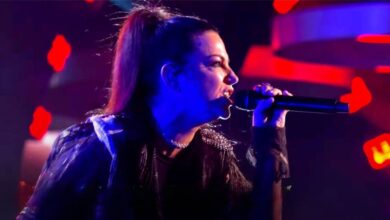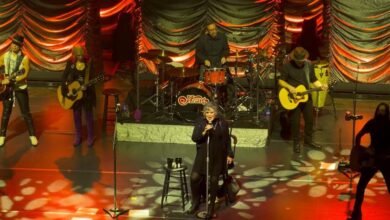Tina S Transforms Beethoven’s “Moonlight Sonata” into a Breathtaking Electric Guitar Masterpiece
Tina S’s rendition of “Moonlight Sonata (3rd Movement)” feels like a moment suspended in time—Beethoven’s stormy masterpiece reborn through the hands of a modern prodigy. Her performance isn’t just a demonstration of speed or technique; it’s a seamless blend of passion, control, and fearless artistry. From the opening tremors to the furious finale, every note radiates a sense of precision and purpose, making this one of the most captivating reinterpretations of a classical work ever played on electric guitar.
From the first seconds, Tina commands attention. The third movement of the sonata, marked Presto agitato, is among the most demanding pieces in the piano repertoire, yet she transforms it effortlessly for guitar. Each passage feels alive, pulsating with rhythmic clarity and melodic urgency. Her ability to preserve Beethoven’s dramatic tension while injecting her own tone and phrasing gives the performance a fresh emotional weight—half tempest, half meditation.
Her focus is total. The camera captures her expressionless concentration, but behind that calm exterior lies fire. The precision of her right-hand picking, the fluidity of her left-hand shifts, and the seamless coordination between both create a performance so technically perfect it borders on unreal. Yet nothing about it feels mechanical; her playing breathes, bending ever so slightly between the notes as if she’s conversing with the composer himself.
The tone she achieves is remarkable. Rather than relying on heavy distortion or studio trickery, Tina uses restraint—balancing clean articulation with enough gain to give the notes bite. The result is a sound that bridges centuries: Beethoven’s Romantic sensibility meets the steel and circuitry of modern rock. The way she alternates between delicate arpeggios and ferocious bursts of power gives the piece its cinematic depth, like lightning striking in slow motion.
The video’s minimalism amplifies its impact. No theatrics, no flashing lights—just Tina, her guitar, and Beethoven. The frame stays tight, emphasizing her hands as they glide effortlessly across the fretboard. Each finger movement becomes choreography, each slide and bend a visual echo of the music’s turbulence. The absence of distraction allows the viewer to connect directly to the sound, to feel the discipline and emotion fused in every gesture.
The structure of her performance mirrors the sonata’s emotional arc. It begins with restrained intensity, gradually building momentum until the energy becomes almost unbearable. Her pacing is impeccable—she never rushes, even as the tempo blazes. This balance between speed and precision gives the performance a controlled chaos, mirroring the spirit of Beethoven’s defiance.
Her interpretation showcases not only virtuosity but vision. Translating a piano sonata to guitar requires more than skill—it demands imagination. Tina doesn’t merely replicate; she reinvents. The way she revoices chords, adapts trills, and sustains melodic lines reveals deep musical understanding. The piece becomes something entirely new while still honoring the architecture of the original.
Listeners often describe a sense of disbelief watching her play. It’s not just that she performs a notoriously complex piece—it’s the ease with which she does it. The transitions are fluid, the phrasing intuitive. Even the most seasoned musicians have praised the performance as an extraordinary feat of technique and control, made even more astonishing by her youth at the time.
Each replay reveals new subtleties. A ghost note here, a perfectly timed vibrato there—details that reward close listening. Unlike many virtuosic covers designed to impress once, this one invites endless revisits. The emotional core grows with each viewing, proving that true mastery lies not in speed alone but in how speed serves expression.
Her “Moonlight Sonata” cover also symbolizes a bridge between generations. Beethoven’s fiery melancholy resonates anew through the language of rock guitar, reminding audiences that great music transcends era or instrument. Classical purists find themselves captivated by her fidelity and phrasing, while rock fans hear their instrument elevated to new heights of discipline and beauty.
Behind the performance is the story of years of dedication. Tina trained classically from a young age, developing a foundation of discipline before transitioning to electric guitar. That blend of technique and imagination is evident in every phrase. Her hands are precise like a concert pianist’s, yet her phrasing carries the emotional boldness of a rock guitarist.
The emotional heart of her version lies in its contrasts. One moment she channels fury, the next she whispers through melody. These shifts create a dialogue between tenderness and intensity that defines both her artistry and Beethoven’s genius. It’s not just impressive—it’s profoundly moving.
Over time, her performance has taken on a mythic quality. Though she hasn’t released many new videos since, this piece stands as a timeless statement of what passion and practice can achieve. Viewers continue to discover it and share it, marveling at how someone so young could channel such maturity and emotional depth.
What lingers after the final note isn’t just awe—it’s gratitude. Gratitude for the proof that Beethoven’s spirit still finds new voices centuries later. Gratitude for the reminder that precision and emotion can coexist. And gratitude for the fact that, sometimes, the simplest stage—a guitar, a camera, a mind in perfect focus—can birth something unforgettable.
In the end, Tina S didn’t just play Moonlight Sonata. She reimagined it. She transformed a 19th-century tempest into a 21st-century revelation, proving that the power of great music lies not in its form, but in the soul that dares to carry it forward.





